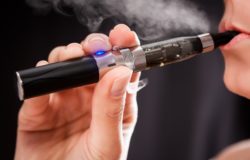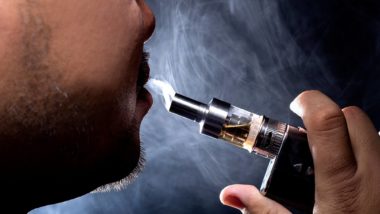Top Class Actions’s website and social media posts use affiliate links. If you make a purchase using such links, we may receive a commission, but it will not result in any additional charges to you. Please review our Affiliate Link Disclosure for more information.

“Vaping” – which uses an electronic device to heat a nicotine oil that creates a vapor that can be inhaled – has been hyped as a “safer” alternative to regular tobacco cigarettes. Vaping does not create tar and the carcinogens found in commercial cigarette tobacco. Manufacturers even claim e-cigarette health benefits when it comes to helping those addicted to smoking in tapering off of nicotine.
The reality of e-cigarette health is much different. The U.S. Surgeon General reports that “vape” may contain a number of harmful ingredients, including diacetyl, a chemical used as an artificial flavoring that has been implicated in respiratory tract injuries and industrial lung diseases, as well as heavy metals such as nickel, tin and lead.
All of this is in addition to highly-addictive nicotine. Use of products such as JUUL e-cigarettes has been associated with seizures, a side effect of nicotine toxicity. Over the past nine years, the FDA has received 35 reports of young people who have suffered seizures attributable to the use of e-cigarettes – and since such reporting is voluntary, it is probably that many more cases have gone unreported.
Are E-Cigarette Health Effects Less Dangerous Than Those of Tobacco?
Compared to conventional, combustible tobacco cigarettes, electronic cigarettes could be a less harmful alternative. According to Centers for Disease Control and Prevention, cigarette smoking is the leading preventable cause of premature death, accounting for nearly 20 percent of all fatalities. Today, cigarette smoking is linked to approximately 90 percent of all lung cancer diagnoses.
The good news about cigarette health is that, as mentioned earlier, “vaping” does not produce tar, which is where most of the carcinogens in cigarette tobacco are found. Neither do e-cigarettes produce carbon monoxide or hydrogen cyanide.
E-Cigarette Health Dangers: Nicotine Addiction
While the “vape” inhaled from e-cigarettes does not produce tar, carbon monoxide or hydrogen cyanide, it still contains nicotine, a potent stimulant derived from the tobacco plant. When inhaled, nicotine’s stimulant properties cause a rise in heart rate and blood pressure.
For centuries after tobacco was introduced to Europe, nicotine was used as an insecticide, a practice that continued well into the 1980s. In the mid-1850s, a Belgian chemist named J.S. Stas assisted law enforcement in identifying nicotine as a poison used in a murder.
In addition to being toxic, nicotine is highly addictive. This has not been lost on tobacco companies; in 2007, a study published in the journal Tobacco Control found that between 1998 and 2005, cigarette manufacturers increased the nicotine content of their products by nearly two percent per year.
Nicotine’s high potential for addiction is a primary reason that the use of vape is not all that useful in tapering off combustible cigarettes. One clinical trial published in The Lancet in November, 2013, suggested that e-cigarettes were “modestly effective” in helping smokers to give up tobacco. However, the researchers warned that “Uncertainty exists about the place of e-cigarettes in tobacco control,” noting that “more research is urgently needed.”
Subsequent research has shown that the use of e-cigarettes has little to no effect on smoking cessation, and may in fact make it even more difficult for someone vaping to quit. In January 2016 a review and meta-analysis carried out by medical researchers at the University of California in San Francisco concluded that e-cigarette users in general had lower success rates when it came to giving up tobacco.
Other Effects of Nicotine
In addition to its stimulant properties, nicotine exposure presents a number of health dangers. According to a publication by the American Diabetes Association, heavy exposure to nicotine may cause insulin resistance, which in turn can lead to type-2 diabetes. Research published in 2012 indicates that tobacco use among teens can have a negative effect in brain development, leading to attention deficit disorder and impair impulse control. It is also a “gateway drug” that increases the potential for addiction overall – another fact of which tobacco companies were long aware, being one reason that cigarette advertising was targeted primarily at youth.
Nicotine Seizures
The aforementioned seizures that result from the use of e-cigarettes is the result of a long-documented side effect of nicotine exposure. Many types of e-cigarettes provide significantly higher concentrations of nicotine than combustible cigarettes. Considering the impact that nicotine exposure exerts on young, developing brains, it should come as no surprise that most victims of nicotine-related seizures are in their teens and early twenties.
A Sweet and Deadly Temptation
The liquid that is used in e-cigarettes itself poses a serious danger to young children who are unsupervised. Many of these “e-liquids” have added flavorings (another potential e-cigarette health danger – see below) and are attractively packaged, making them a temptation to young children who may have an inclination to have a taste. Ingesting even a small amount of nicotine can result in seizures, vomiting and even death. One teaspoon of e-liquid can be enough to kill a young child.
More Chemical Threats
The diacetyl used to flavor e-cigarette liquids has been linked to a rare respiratory condition known as bronchiolitis obliterans. Known colloquially as “popcorn lung,” this disease is an inflammation of the bronchioles, which are the smallest air passages in the lungs, leading into the tiny, grape-like clusters of air sacs known as alveoli. This is a progressive disease that reduces lung capacity over time, subjecting the victim to dry coughing, shortness of breath, wheezing and chronic fatigue.
Two other chemicals found in e-liquids are propylene glycol and glycerol. The former is used in the production of polyester and acrylic paints, but also as an additive in many processed foods. While health authorities in the U.S. and the E.U. have declared propylene glycol to be “generally safe” to use in food, it is known to cause or contribute to seizures and unconsciousness when ingested in large amounts. Furthermore, this chemical may decompose when heated, separating into its more toxic components, such as formaldehyde (a chemical used as embalming fluid). With new, more powerful “vape pens” that heat e-liquids to higher temperatures, this is a serious concern. The same problems way arise with glycerol as well.
“Juuling”
Among e-cigarettes, the Juul is of particular concern. A story recently published on Vox described young people who have quickly gotten addicted to vaping. Not only is “Juuling” very popular among youth and young adults, adding a “peer pressure” aspect to the problem, but it delivers a much heavier dose of nicotine than other competing products.
According to one source cited in the story, the company that produces the Juul commands more than 50 percent of the e-cigarette market. That market share and the staggering amounts of revenue it produces for the company is a major reason why Juul and other e-cigarette manufacturers have little incentives to police themselves – and are fighting attempts to regulate their products at every turn.
The FDA Starts Cracking Down
In April, 2019, FDA Commissioner Scott Gottlieb announced new rules and regulations governing the sales of e-cigarettes, requiring certain companies, including Juul Labs, to provide more detailed information about their products and possible e-cigarette health effects. However, Gottlieb also gave the industry three more years to comply with the new regulations – meaning that Juul Labs and other industry players will not have to provide this public information about their products until 2022.
This delay means that hundreds of thousands, even millions of young people could find themselves addicted. At the same time, Juul has launched an aggressive marketing and promotion campaign in order to attract more customers.
Can E-Cigarette Companies Be Held Liable?
On May 6, 2019, the Sarasota, Fla. Herald-Tribune reported that a 15-year-old girl and her family had filed a class action lawsuit against Juul Labs and its major investor, Altira Group LLC (which also has an ownership stake in tobacco giant Phillip Morris).
The lead plaintiff in the lawsuit, known only as “A.N.,” claims that she became addicted to Juul after only a year, and now suffers from seizures as a result. She says she was unaware that the product contained nicotine at the time she began using it, and had even accidentally swallowed small amounts of the e-liquid. According to the complaint, Juul labs has been “mimicking Big Tobacco’s past marketing practices, defendants prey on youth to recruit replacement smokers for financial gain.”
The complaint alleges that the companies intentionally targeted teenagers in their advertising and marketing, violating federal racketeering laws. The defendants deny the allegations, and have attempted to reassure the public that they are taking action to discourage the use of their products by underage youth. According to a Juul Labs representative, the company plans to deactivate its social media marketing campaigns while suspending distribution of its e-liquid “pods” to over 90,000 retail outlets and requiring online consumers to provide evidence that they are at least 21 years of age.
Join a Free JUUL E-Cigarette Class Action Lawsuit Investigation
If you or your child suffered seizures after vaping with a JUUL e-cigarette, you may benefit from participating in a free JUUL class action lawsuit investigation.
This article is not legal advice. It is presented
for informational purposes only.
ATTORNEY ADVERTISING
Top Class Actions is a Proud Member of the American Bar Association
LEGAL INFORMATION IS NOT LEGAL ADVICE
Top Class Actions Legal Statement
©2008 – 2024 Top Class Actions® LLC
Various Trademarks held by their respective owners
This website is not intended for viewing or usage by European Union citizens.
Get Help – It’s Free
Join a Free JUUL E-Cigarette Class Action Lawsuit Investigation
If you qualify, an attorney will contact you to discuss the details of your potential case at no charge to you.
PLEASE NOTE: If you want to participate in this investigation, it is imperative that you reply to the law firm if they call or email you. Failing to do so may result in you not getting signed up as a client or getting you dropped as a client.
E-mail any problems with this form to:
Questions@TopClassActions.com.












